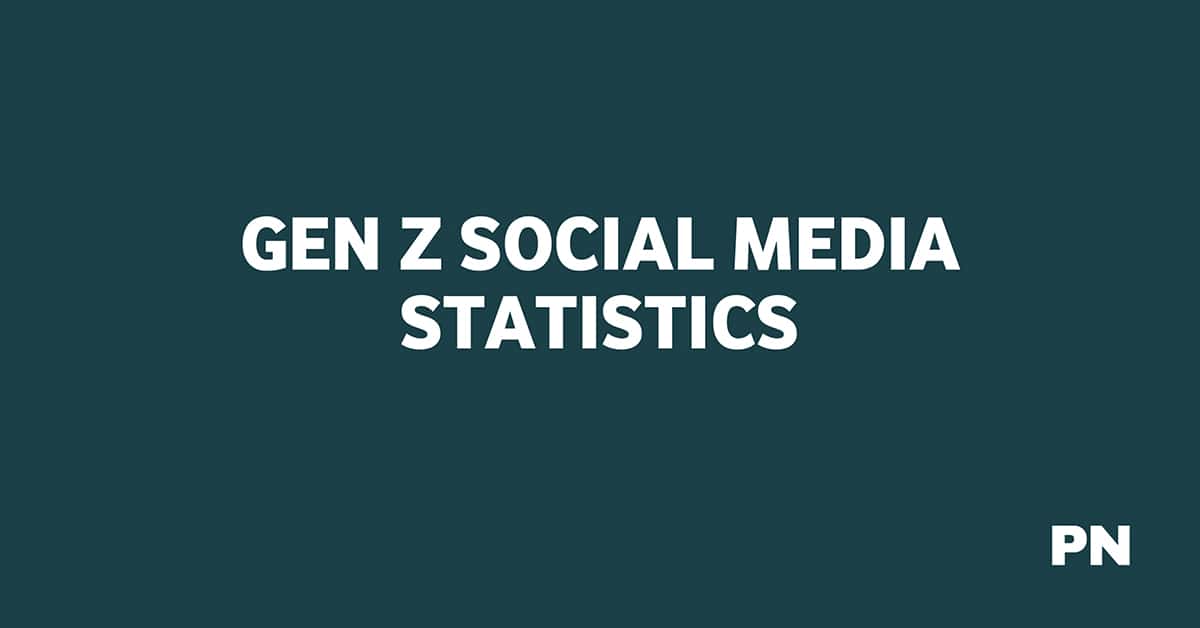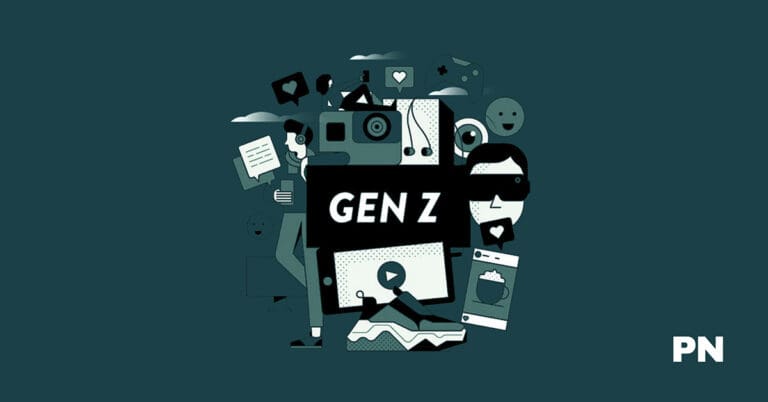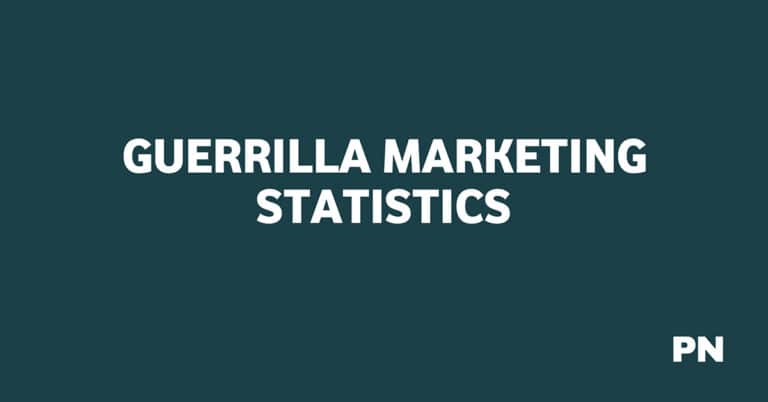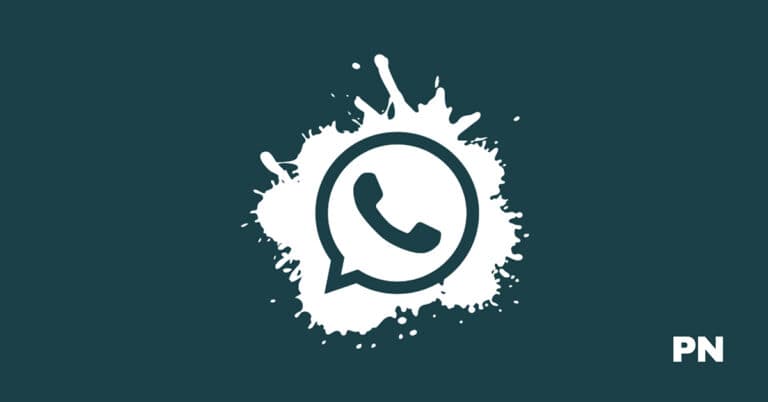35 Gen Z Social Media Statistics: Insights into Zoomer’s Habits

Understanding Generation Z’s relationship with social media offers valuable insights for marketers, educators, and policymakers.
Generation Z encompasses the cohort born between 1997 and 2012, a group that interacts with technology and the internet from a young age.
One standout statistic reveals that nearly all Gen Z users turn to YouTube, with over 90% of them using the platform, emphasizing its dominance in their daily media consumption.
Social media platforms serve as entertainment hubs for this generation and play a crucial role in their shopping decisions, communication, and digital content creation.
Let’s see what the statistics say about Gen Z social media.
1. 97.5% of Gen Z cites social media as their primary source of shopping ideas.
(Source: Influencer Marketing Factory)
Platforms like Instagram, TikTok, and Pinterest are highly visual, making them ideal for discovering new products and styles.
Gen Zers can easily browse images and videos to find inspiration for their next purchase.
Many Gen Zers follow social media influencers specializing in fashion, beauty, or lifestyle content.
These influencers often showcase products and brands that they recommend, which can influence Gen Zers’ shopping decisions.
2. Gen Z averages 3 hours daily on social media.
(Source: Oberlo)
Gen Z, also known as the technology age, is very much invested in social media.
Many Gen Zers use social media platforms like Snapchat, Instagram, and TikTok to stay in touch with friends and family. Hence, they spend more time on social media,
In truth, Gen Zers find a sense of belonging and community on social media platforms, where they can connect with like-minded people who share their interests and values.
3. 70% of Gen Z watches YouTube daily.
(Source: Gitnux)
YouTube has become a daily habit among Gen Z. It offers a wide range of content, from educational videos to entertainment, gaming, and more.
This variety appeals to Gen Z’s diverse interests and preferences.
Also, YouTube is free and accessible to anyone with an internet connection, making it a convenient source of entertainment and information for Gen Z.
4. About 46% of Gen Z follow over ten influencers on social media.
(Source: Reuters)
This highlights the importance of influencer marketing for brands looking to reach this demographic.
| Platform | Usage by Gen Z Influencer Followers |
|---|---|
| High | |
| YouTube | Very High |
| TikTok | Rising Rapidly |
Given this data, brands are keen to collaborate with influencers who command the attention of your generation.
Consequently, influencer marketing has become a crucial strategy for companies aiming to reach the influential Gen Z market segment.
Your interactions and engagements with these personalities underscore the symbiotic relationship between influencers and their Gen Z audience.
5. Three-quarters of Gen Z people used YouTube at least once a day, and 19% used it at least once a week.
(Source: Pew Research Center)
Many Gen Zers are fascinated by YouTube videos. They follow and engage with their favorite YouTube creators, who produce relatable, authentic content often tailored to their interests.
To get this demographic more hooked, YouTube’s algorithm suggests videos based on a user’s viewing history, making it easy for Gen Z to discover new content they will likely enjoy.
6. In a January 2023 research of U.S iOS users, 92% of Generation Z users aged 16 to 25 used YouTube.
(Source: Statista)
YouTube’s focus on video content aligns well with Gen Z’s visual and interactive media preferences.
As a platform offering short-form and long-form content, YouTube provides various options for Gen Z users, from quick, entertaining clips to in-depth tutorials and educational videos.
Other video platforms like TikTok are fast gaining traction for Gen Z’s preference.
7. Gen Z has an attention span of 8 seconds on social media.
(Source: Stibo DX)
Social media has endless content, leaving Gen Zers to quickly scan and evaluate information to determine what is worth their time and attention.
Brands and content creators looking to engage with Gen Z on social media must work harder than ever to capture their audience’s attention in seconds.
This could involve creating visually striking content that stands out in a crowded feed.
You could use attention-grabbing headlines or captions or leverage popular trends and challenges to tap into what is already capturing Gen Z’s interest.
Gen Z’s attention spans are short, and they are easily distracted.
With multiple devices and platforms competing for their attention, you should find ways to cut through the noise and deliver their message in a way that is concise, engaging, and memorable.
8. 81% of Gen Z discover new products and services through social media.
With Gen Z spending an average of 3 hours per day on social media, it’s no surprise that they are turning to these channels to discover and research new products.
This shows the importance of having a strong social media presence and strategy to reach and engage with Gen Z consumers.
By leveraging popular social platforms, brands can showcase their products creatively and engagingly, build relationships with their audience, and drive sales.
Gen Z values authenticity and transparency from brands.
They want to see real, unfiltered content that reflects their values and interests and are likelier to trust and purchase from brands that demonstrate these qualities on social media.
9. 85% of Generation Z say social media affects their purchasing decisions.
(Source: RetailDive)
Social media has also made it easier for consumers to discover new and niche brands they may not have been aware of otherwise, leading to increased competition and innovation in the market.
Social media algorithms are highly effective at targeting consumers with personalized content and advertising, making it easier for brands to reach their desired audience and drive conversions.
Hence, Gen Zers can easily discover products or services they need.
10. 77% of Gen Z prefer to shop from brands they follow on social media.
(Source: Sprout Social)
Unlike previous generations, Gen Z sees social media as a way to build relationships with brands and stay up-to-date on their latest offerings.
For brands, social media is no longer just a marketing channel but a critical component of their overall customer experience.
By creating engaging and authentic content, responding to customer inquiries, and building a community of loyal followers, brands can build trust and loyalty with Gen Z consumers, increasing sales and customer retention.
11. Gen Z uses an average of five social media networks daily.
Gen Z is constantly connected and consumes content across various channels.
However, each platform serves a different purpose.
While some platforms, like Instagram, may be used for sharing photos and connecting with friends, others, like LinkedIn, may be used for professional networking.
By using multiple platforms, Gen Z can meet various social and professional needs.
Gen Z is highly attuned to the latest trends and news, and social media provides a way to stay up-to-date in real-time. By using multiple platforms, they can ensure they’re not missing out on important updates or conversations.
This means you should ensure you connect with your target audience on any social media platforms they may use.
12. Gen Z adults are likelier to use Facebook than Gen Z teens.
(Source: eMarketer)
One possible explanation for this trend is that Facebook was among the earliest and most dominant social media platforms.
As a result, it may be more deeply ingrained in the daily habits of older Gen Z adults who were early adopters of the platform.
Additionally, Facebook may be seen as a more “mature” platform better suited for professional networking and keeping in touch with family members. Hence, it’s more appealing to Gen Z adults entering the workforce and starting families.
In contrast, younger Gen Z teens may prefer more visual and ephemeral platforms like Instagram, Snapchat, and TikTok.
These platforms are better suited for sharing short-form video content and connecting with peers.
They are also newer and may be seen as more cutting-edge and innovative than older platforms like Facebook.
13. Over 80% of US Gen Zers aged 15 to 26 use YouTube monthly, with nearly the same percentage using Instagram or TikTok.
(Source: eMarketer)
When examining your engagement on social media platforms, you’ll find that YouTube, Instagram, and TikTok are dominant players in capturing your attention.
Similarly, engagement on Instagram and TikTok is nearly on par with YouTube.
These platforms’ visual and interactive nature resonates with your lifestyles and preferences. With its wide range of features from Stories to IGTV, Instagram caters to your desire for creative expression and connectivity.
Meanwhile, TikTok’s rise to prominence has been fueled by its short-form video content that perfectly suits your on-the-go consumption habits and creative flair.
It’s important to note that while these platforms share high usage rates, each caters to unique aspects of social interaction and content consumption, reflecting the varied ways you stay informed, entertained, and connected.
14. 77% of Gen Z get their news from social media.
(Source: eMarketer)
While traditional news outlets have long been the primary source of information for older generations, Gen Z has grown up in a digital era where social media platforms have become ubiquitous and highly influential.
For Gen Z, social media is a key source of news and information, providing a more immediate and interactive way of staying current on current events.
15. Streaming video content accounts for around 40% of Generation Z’s digital time.
One key reason video content is popular among Gen Z is its ability to convey information in a highly engaging and immersive way.
Whether binge-watching a new series on Netflix or scrolling through short-form videos on TikTok, video provides a dynamic and visually stimulating experience that holds the attention of younger audiences.
Additionally, the availability of video content across various devices, from smartphones to smart TVs, has made it easier for Gen Z to consume video content at their convenience.
This accessibility has contributed to Gen Z’s increasing engagement with video content online.
16. 56% of Gen Z users use social media to communicate.
(Source: Gitnux)
One key reason social media has become such a prevalent form of communication among Gen Z is its convenience and accessibility.
With a few taps on their smartphone, Gen Z users can send messages, share photos and videos, and engage in real-time conversations with people worldwide.
This ease of use has made social media a go-to method of communication for many Gen Z individuals, particularly those who are digital natives and have grown up with technology as a central part of their lives.
Furthermore, social media provides a platform for Gen Z to express themselves and showcase their personalities in ways that may be more difficult or less comfortable in face-to-face interactions.
Through their social media profiles, Gen Z users can curate their online identities, share their thoughts and opinions, and engage with others who share their interests and values.
17. Social media users in the United States aged 18 to 24 spend an average of more than 1,500 minutes watching YouTube content.
(Source: Statista)
YouTube’s success among younger audiences can also be attributed to its emphasis on user-generated content and community engagement.
Features like comments, likes, and shares enable viewers to interact with creators and each other.
This fosters a sense of community and connection that particularly appeals to younger audiences who value social interaction and self-expression.
Other platforms like TikTok and Instagram have also been used for a long period.
Time Spent on Social Media Platforms by Gen Z in the U.S. (in minutes):
| Platform | Average Minutes |
|---|---|
| YouTube | >1,500 |
| TikTok | 765 |
| 512 |
Gen Zers spend longer periods on video-based social media platforms than text-based ones.
18. As of January 2023, the most popular TikTok searches among Gen Z users were “how to…”
(Source: Statista)
The leading type of query you frequently explored starts with “how to…” highlighting an active interest in tutorials, DIYs, and educational content among your peers.
19. Meta’s Facebook was used by 45% of males and 54% of female U.S. Gen Zers.
(Source: Marketing Charts)
Female Gen Zers are slightly more likely to be Facebook users than their male counterparts.
One possible explanation for this gender gap is the differing social needs and preferences of male and female Gen Zers.
Studies have shown that females tend to value social connection and communication more than males, which could make a platform like Facebook more appealing to them.
Additionally, Facebook’s content and features may align more with the interests and needs of female Gen Zers, such as the emphasis on personal updates, photo sharing, and group discussions.
20. 64% of male and 70% of female U.S Gen Zers used Snapchat.
(Source: Statista)
Snapchat’s focus on brief content, visual storytelling, and personal expression has made it a favorite among Gen Z, who value creativity and authenticity in social media interactions.
One reason for Snapchat’s success among Gen Z may be its emphasis on privacy and intimacy.
Unlike other social media platforms that prioritize public sharing and viral content, Snapchat allows users to share snaps and messages that disappear after being viewed.
This creates a sense of privacy and intimacy that resonates with younger users.
Additionally, Snapchat’s filters and lenses have become a cultural phenomenon among Gen Z users.
They allow users to transform their appearance and create unique and entertaining content to share with friends. This emphasis on creativity and self-expression particularly appeals to a generation that values individuality and personal expression.
21. 62% of male and 75% of female U.S Gen Zers use TikTok.
(Source: Morning Consult)
TikTok’s focus on short-form video content, viral trends, and creative self-expression has resonated strongly with Gen Z, seeking new and innovative ways to connect and create online.
TikTok’s success can be attributed to several factors, including its highly personalized and addictive recommendation algorithm.
The algorithm serves a never-ending stream of entertaining and engaging content tailored to each user’s interests.
The platform’s emphasis on community and collaboration, with features like duets and challenges, has also helped to create a sense of shared experience and belonging among Gen Z users.
22. 93% of male and 84% of female Gen Zers in the U.S. use YouTube.
(Source: Marketing Charts)
YouTube’s dominance in video streaming and its diverse and ever-growing library of content has made it a go-to destination for Gen Z across genders.
YouTube is popular due to its ability to cater to various interests and preferences.
From gaming and beauty to music and education, YouTube offers various channels and content creators that appeal to different audiences within the Gen Z demographic.
Additionally, YouTube has become a powerful platform for personal expression and creative entrepreneurship, with many Gen Zers launching their channels and building personal brands.
This emphasis on creativity and self-expression aligns with the values of Gen Z, who prioritize individuality and authenticity in their social media interactions.
23. Half of the Gen Z surveyed respondents stated Facebook was the social media platform that contributed the most to empathy exhaustion.
(Source: Statista)
Empathy exhaustion, or “empathy burnout,” refers to feeling emotionally drained or overwhelmed by constant exposure to negative or distressing content on social media.
Social media can negatively impact mental health and well-being, particularly among younger audiences.
With Facebook’s emphasis on public sharing and the potential for contentious discussions and debates, it’s unsurprising that many Gen Z users find the platform particularly draining.
24. 42% of 13- to 17-year-old boys thought they could express themselves freely online. Girls of the same age were less likely to feel free to share their opinions online, with only 33% agreeing with the statement.
While a slight majority of boys feel comfortable sharing their opinions and perspectives online, girls are more likely to feel restricted or hesitant.
Several potential factors could contribute to this gender disparity in online self-expression.
One possibility is that girls may face more negative consequences for expressing themselves online, such as harassment, cyberbullying, or judgment from peers.
Additionally, societal gender norms may discourage girls from speaking out or sharing their opinions, particularly on controversial or sensitive topics.
25. 45% of Gen Z respondents stated there is too much pressure to be perfect on social media.
(Source: Statista)
With social media often presenting a curated and idealized version of people’s lives, it’s easy to feel inadequate or insufficient in comparison.
This pressure to be perfect can lead to a range of negative outcomes, including anxiety, depression, and body image issues.
Some Gen Z users may feel compelled to constantly edit and filter their photos, present a polished and curated version of their lives, and suppress negative emotions or experiences.
It’s important for social media users to recognize the limitations and biases of social media and to prioritize their well-being over the need to present a perfect image.
26. Teenage girls in the United States spend approximately two hours and forty minutes daily on TikTok.
(Source: Statista)
The amount of time spent on TikTok by teenage girls is significantly higher than that of other social media platforms, highlighting its unique appeal to this demographic.
The immersive and engaging nature of TikTok’s content and its ability to provide a constant stream of new and relevant videos may contribute to the longer time spent on the platform.
While TikTok can provide enjoyment and creative expression for teenage girls, it’s important to consider the potential impact of excessive social media use on mental health and well-being.
Encouraging balanced and mindful social media habits ensures that teenage girls have a positive and healthy experience on TikTok and other social media platforms.
27. 65% of teenage girls in the United States believed that YouTube positively impacted their peers.
(Source: Common Sense Media)
One key benefit of YouTube is its ability to provide access to educational content and tutorials on virtually any topic.
Whether learning a new skill, exploring a hobby, or getting help with schoolwork, YouTube has become a go-to resource for many teenage girls seeking to broaden their knowledge and skills.
Additionally, YouTube provides a platform for diverse voices and perspectives, helping to promote understanding and empathy among teenage girls and their peers.
By exposing users to different cultures, lifestyles, and viewpoints, YouTube can help to break down barriers and foster a more inclusive and accepting society.
28. 43% of respondents thought TikTok had a primarily positive effect on persons their age, while 26% said it had a mostly negative one.
On the positive side, TikTok has been praised for its ability to provide a platform for creative self-expression, community building, and social connection.
The app’s short-form video format and engaging algorithm have helped to propel TikTok to the forefront of social media culture, particularly among younger audiences.
However, concerns have also been raised about the potential negative impact of TikTok on mental health, body image, and privacy.
Some critics argue that the app’s addictive nature and focus on curated and idealized content can contribute to feelings of inadequacy, anxiety, and depression among users.
29. 15% of digital creators in the U.S. are Gen Z.
(Source: Statista)
While Gen Z may not make up the largest share of digital creators, they are a significant and growing force, bringing new ideas, perspectives, and technological expertise.
Gen Z creators are often driven by a desire for self-expression, creativity, and social connection rather than just financial gain.
This passion and authenticity have helped many Gen Z creators build dedicated and loyal followings, even without massive audiences or corporate backing.
30. Gen Z is more likely than the general public to buy things advertised by celebrities or influencers.
(Source: Kadence)
Celebrities and influencers significantly influence your purchasing choices, especially if you’re part of Generation Z.
Research suggests that almost half (44%) of Gen Z consumers purchase based on an influencer’s recommendation, compared to just 26% of the broader population.
Social media platforms such as YouTube and Instagram are key venues where influencers hold sway.
The majority of Gen Z follows at least one influencer on these platforms. This means influencer marketing is a vital strategy in reaching and resonating with this demographic.
Collaborating with well-known personalities who resonate with the Gen Z audience can benefit your brand’s advertising strategies.
The right influencer can dramatically drive your product’s appeal to this generation, translating into direct sales.
However, selecting influencers who embody brand values and genuinely connect with their followers is crucial for the most authentic and effective impact.
31. 35% of Gen Zers use social media for over 2 hours daily.
(Source: McKinsey)
32. According to Statista, Snapchat will have 49.5 million Generation Z users in 2024., as it strives to cater to your unique media consumption habits.
(Source: Statista)
With nearly half of all Snapchat users expected to be Gen Z by that time, it’s clear that the platform has struck a chord with this demographic.
It provides a unique and engaging social media experience that resonates with their preferences and values.
As Snapchat continues to evolve and innovate, it’s likely to maintain its position as a leading social media platform for Gen Z.
By staying attuned to this demographic’s needs and preferences, it can continue to provide a valuable and engaging social media experience for millions of users worldwide.
33. Instagram is the most used social media platform among Gen Zers in the U.K., with 71% using it.
(Source: Statista)
Instagram’s focus on visual storytelling, filters, and influencer culture has made it a go-to destination for Gen Z users looking to share their lives, connect with friends, and follow their favorite creators.
The high usage rate of Instagram among Gen Zers in the U.K. also reflects the platform’s ability to evolve and adapt to changing user preferences and trends.
From the introduction of Instagram Stories and Reels to the increasing emphasis on e-commerce and social shopping, Instagram has consistently innovated to stay relevant and engaging for younger audiences.
34. 70% of U.K Gen Zers use TikTok and YouTube daily.
(Source: Statista)
TikTok and YouTube have become integral components of daily routines for many Gen Z users in the U.K., providing a source of entertainment, education, and social connection.
These social platforms allow users to engage with creators, participate in challenges and trends, and connect with like-minded individuals.
35. BeReal is the least used social media platform among Gen Zers in the U.K.
(Source: Statista)
BeReal, a French social media app launched in 2020, has gained attention for its unique photo-sharing approach.
Unlike other platforms, BeReal prompts users to take and share a photo of their current surroundings within a randomly selected two-minute window each day, with no filters or editing tools available.
Despite BeReal’s growing popularity, the app remains less widely used than other social media platforms among Gen Zers in the U.K.
One possible reason for this is the app’s relative newness and limited features, which may make it less appealing to users who value a more robust and diverse set of social media functions.
Additionally, BeReal’s focus on spontaneous, in-the-moment sharing may not appeal to all users, particularly those who prefer to curate their online presence carefully or have concerns about privacy and safety.
Frequently Asked Questions
What social media does Gen Z use most?
Generation Z is highly active on YouTube, with statistics indicating a significant preference for this platform over others. It serves not only as an entertainment hub but also as a source of information and educational content.
How much social media does Gen Z use worldwide?
Globally, Gen Z individuals spend substantial time on social media, with some reports suggesting that they spend several hours each day on these platforms. The time spent can vary by country and individual habits.
What does Gen Z care about most?
Gen Z tends to value entertainment and social connection through social media. They also strongly prefer diversity and equality, with a positive response to brands that promote these values on social platforms.
How does Gen Z use social media differently?
Unlike previous generations, Gen Z uses social media not just for communication but also heavily for entertainment, such as scrolling through videos and watching sports clips. They engage with content more actively, like participating in challenges and creating their own content.
Conclusion on Gen-Z Social Media Statistics
Gen Z’s use of social media shows how this generation is shaping the future of digital communication.
As the first generation to grow up with social media, Gen Z uses these platforms to connect, express themselves, and learn about the world.
The statistics reveal how Gen Z uses social media, from visual platforms like Instagram and TikTok to more authentic apps like BeReal.
As Gen Z continues to influence social media, it’s important to understand their preferences and behaviors. This can help us appreciate the power of these platforms to engage and inspire young people worldwide.
Disclosure: We may earn commissions if you buy via links on our website. Commissions don’t affect our opinions or evaluations. We’re also an independent affiliate of many platforms, including ClickFunnels, Kartra, GoHighLevel, Podia, Northwest Registered Agent, and others. We’re not employees of these services. We receive referral payments from them, and the opinions expressed here are our own and are not official statements of these companies.





